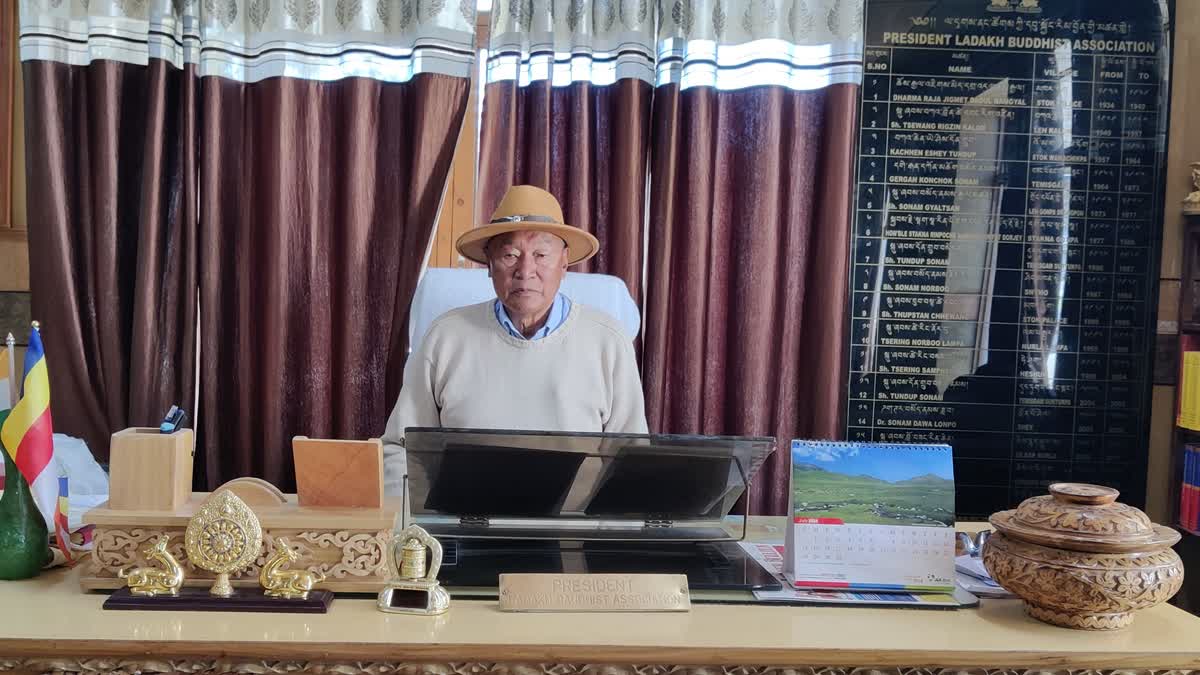Leh (Ladakh): Amid demand by the Leh Apex Body and Kargil Democratic Alliance for reservation under the Sixth Schedule for the Ladakhis, Union Home Minister Amit Shah last month announced formation of five new districts in the Union Territory.
While the local BJP leadership in Ladakh has welcomed the move, former minister/ vice-president of Leh Apex Body, Chering Dorjey Lakrook said that the creation of five new districts was an attempt to weaken the demand of Statehood and 6th Schedule.
In an exclusive Interview with ETV Bharat, Dorjey, who also holds the position of President of Ladakh Buddhist Association, shared his views about the recent announcement of the five new districts to Ladakh and how it will change the administrative landscape of Ladakh. Here are a few excerpts from the interview:
ETV Bharat (ETVB): How do you see the announcement of these five new districts in Ladakh?
Chering Dorjey Lakrook (CDL): I see this as an attempt to weaken the demand of Statehood and 6th Schedule; if this is the case then government is wrong because we have been getting a lot of support for the ‘Delhi Chalo Andolan’. This shows that people are not satisfied with the Districts. People have understood that until we get Statehood and 6th schedule our major problems cannot be solved. Without safeguard what is happening immediately in Ladakh is that many projects are coming to Ladakh. For instance, in Spang Skyanchu-thang in eastern Ladakh, a huge amount of land is given for the solar project and the project is underway. Recently, I visited the place and found out that a lot of livestock and wildlife are dependent on it. Now, the question is where will all the livestock and wildlife go and what will happen to them. They are planning to complete this project in two years. If this kind of development happens we need to think about this. We should have the power to decide what kind of project and where it has to be carried out. This is one of the areas where we produce Pashmina and the economy of Ladakh and the source of livelihood of the people of Ladakh is dependent.
ETVB: How do you think that the announcement of the new districts will change things on ground level?
CDL: People have welcomed this decision be it villagers or political parties. But on the other hand, many things are not clear, for example Zanskar demand is very genuine as it remains cut off from the district headquarters for six months in winter and it is 240 km away from the district headquarters. Whether Zanskar will have a separate council is also a question because in the present set-up, it has only three councillors. Even after announcing a separate district for Zanskar, if they are planning to keep Zanskar with Kargil LAHDC then it will make no sense. Because whatever development in Ladakh takes place it is through Council only. All the decisions related to funding and development will be decided by LAHDC Kargil. So in that case there isn’t any benefit for the people of Zanskar.
ETVB: What will be the advantages of this creation of the new districts?
CDL: In terms of employment, a lot of opportunities would be there only if they speed up the drafting/framing of the recruitment rules. The matter is that today most of the well-educated youths are without jobs. If they create posts and recruit, then it will benefit, otherwise if they hire people on outsourcing and contractual basis then it is of no benefit to the local aspirants. Then aspirants will face the issue of overage. It is a big failure on the part of the UT administration not being able to frame recruitment rules on time, not setting up the Public Service Commission (PSC) and not creating posts. Second, there is no clarity on the reservation issue. Since, we belong to Schedule Tribe (ST category), reservation should be there. At present, we are issued with Ladakh Resident Certificate (which is only for Non-Gazetted posts) but tomorrow if someone challenges it in court, it may become invalid and to be dependent on it is difficult until and unless we get reservation under sixth schedule.
The government should implement it at the earliest. Before post creation, the government should set up all the infrastructure which will need a lot of funding and then set up things and then finally the appointment, then we can call it a functional district.
Infrastructure-wise even today we are not sufficient. At present, UT administration doesn’t have their own set-up. It is run in the Council Secretariat. UT administration is an example where all the LAHDC employees are being utilised including the Class IV employees. If this kind of thing happens in the new set-up, then it is just an eyewash to the people.
One of the biggest drawbacks in Ladakh is regarding the funding, though the funding of the UT Ladakh has increased multi-fold but only 10 % of the budget goes to Ladakh Autonomous Hill Development Councils LAHDCs and the public doesn’t have any say on the remaining 90% of the budget. Secondly, there are many complaints that all the decisions are made by the bureaucrats without consulting the locals.
Read more:



